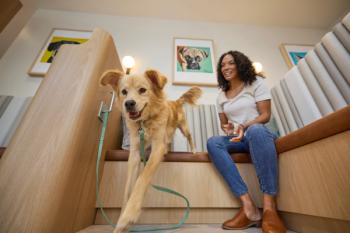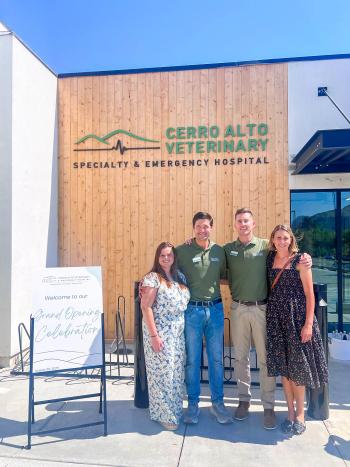
Rent right
You don?t have to own a facility to make a major impact on your practice?s layout and design.
A leasehold is likely your best option if you don't have a lot of money to put into building a new facility or you're in an urban area where prime land just isn't up for grabs. With leaseholds, you can get the space you need to establish a new practice. And while there are certain restrictions, you can still put your imprint on the design.
New York Cat Hospital
143 Freedom Place
New York, NY 10069
Type: Feline exclusive
Square footage: 1,500
Interesting features: Located in Trump Place, luxury boarding, Web cam for monitoring hospitalized patients from any computer
Architect: Michael Davis, Michael Davis Architects
Coal Mine Animal Hospital
6740 S. Pierce St.
Littleton, CO 80128
Type: Small animal
Square footage: 2,986
Interesting features: Peepholes into exam rooms, recessed cubbies in treatment island, low exam room table for big dogs
Architect: Jeff Keast, Keast Architecture
Integrative Pet Care
2520 West Armitage Ave.
Chicago, IL 60647
Type: Rehabilitation
Square footage: 5,931
Interesting features: Brick Chicago loft building constructed in the early 1900s, heavy timber-and-post construction, hydrotherapy room
Architect: Chris George, Chris George P.C. Architect
Making the leap
One big advantage of leaseholds is that you aren't left with the headache of a real estate transaction. So you can focus more of your energy on getting your new business off the ground. Leaseholds require a smaller financial investment than building from the ground up, too. "We wanted to invest the capital we had into starting our business—not real estate," says Stacy Nigrelli, co-owner of Integrative Pet Care in Chicago. Still, there are tradeoffs.
Site selection: Be aware, be very aware
For one thing, if you decide to sell your business, you can't sell the building. You can only sell the practice and the improvements you've made. Drs. Erica Runkle and Jill Levy, owners of the Coal Mine Animal Hospital in Littleton, Colo., had concerns about putting down a big chunk of money for leasehold improvements on a building they didn't own. But financially, they realized it was the smartest thing to do, especially with all the competition the team faced in the area.
Competition and financial limitations aside, if you're looking to open a practice in a large urban area, leasing may be your only affordable option in markets where real estate prices are sky-high. "In New York, unless you're particularly wealthy, you don't have the options you have elsewhere where you can buy property and build from scratch," says Dr. Peter Soboroff, owner of New York Cat Hospital in New York City. Given this financial reality, the ideal spaces are usually only available for rent.
Know what you're getting into
Landlords exercise tight control over their domain, from signage, exterior lighting, and the view through the windows from the street, to specific requirements about venting and equipment. And the landlord will want to approve your design plans. But your landlord can also be your knight in shining armor. When something goes wrong—like the roof springs a leak—it's the landlord's responsibility to fix it. The key is to get all these details hammered out on paper.
Framing a lease can be a nightmare, so it's important to sharpen your negotiating skills and hold your ground. "Landlords will put ridiculous things into the lease and hope you don't read it before you sign," says Dr. Runkle. An early draft of her lease said the landlord was entitled to a percentage of her practice's gross sales every year. That didn't fly with her and her partner. They hired a lawyer to look over the lease and help them negotiate with the landlord until both sides came to terms they could agree on. "There was a time when we put our foot down and we didn't know how the landlord would respond," says Dr. Runkle. "We said we'd walk away if he didn't accommodate us. And he did."
Before you sign the lease, make sure both parties clearly understand what design work and maintenance the landlord will shoulder—and be sure that is detailed in the lease. Nigrelli and her team started the process with a letter of intent that outlined what parts of the renovation they would pay for—and what they expected the landlord to foot the bill for.
The length of the lease is another key item to negotiate. In Dr. Soboroff's case, he wanted the longest lease he could get. "If I had to renegotiate a lease in five years the rent would at least double," he says. "And I can't afford that."
Strategic planning: Best-laid floor plans
Home away from home
The perfect leasehold space brings your practice regular foot traffic and high visibility. For example, Coal Mine Animal Hospital sits just two doors down from a major grocery store chain—a location the owners find ideal. "So many clients come in and say, 'You're the only vet around here,'" Dr. Runkle says. "But that's not true. We're just the most visible."
One caution: Don't get your heart set on a particular site until you're sure it's zoned for a veterinary practice. Otherwise you could end up spending thousands of dollars on the design only to learn that you can't legally occupy the space. "You've got to be dead sure about zoning—so check and double-check," says Dr. Soboroff.
Newsletter
From exam room tips to practice management insights, get trusted veterinary news delivered straight to your inbox—subscribe to dvm360.






